
AS FEATURED IN

Power Strathspey Triplets Exercise
by Jori Chisholm, Founder of BagpipeLessons.com
Last Updated: April 11, 2025
I’m Jori Chisholm from BapgipeLessons.com. Today’s exercise will improve your fingering power, speed, control and consistency. It focuses on a note pattern that demands quickness and lightness, called Power Strathspey Triplet. The exercise is from my popular series of power exercises. Download the free Power Strathspey Triplets exercise from our website and join our Inner Circle membership for exclusive access to hundreds of lessons, tunes, videos, and live classes designed to elevate your piping to the next level. Whether you’re just starting out or have years of experience, this video will provide you with the insights and techniques to play doublings flawlessly every time. Let’s transform your piping together!
Watch the video and scroll down to read the full video script.
Video Transcript: Today, we’re diving into another essential exercise from my Power Exercises series, aimed at refining your bagpipe technique. This session focuses on Power Strathspey Triplets, a fundamental note combination in strathspeys. We’ll look at how these triplets are commonly written in the sheet music and how this can be very confusing and misleading, and how they actually should be played. We’ll talk about how triplets in strathspeys are similar to and different from the triplets we commonly see in jigs and 6/8 marches.
This exercise is a part of the Power Exercises series I’ve created to refine your fingering and ensure your gracenotes are executed flawlessly. The series, which includes exercises like Power Doublings, Power Tachums, and more, is available exclusively to members of my BagpipeLessons.com Inner Circle. Membership grants you access to weekly live classes, an extensive lesson library, and personalized support. Learn more at BagpipeLessons.com/membership.
The Power Strathspey Triplets exercise is designed to perfect your triplet execution in strathspeys, emphasizing speed, rhythm, and control. The first thing we need to look at is the difference between how these triplets look when you see them in your tunes. Take a look at this note combination, found in many strathspeys. It’s written as a C doubling on a short C followed by an E gracenote to Low A.
But despite that fact that it is written that way, it’s actually a triplet. Look at the C doubling, in between the high G gracenote and D gracenote is a C. That’s the theme note of the C doubling. Now look at the C after the doubling. It’s a cut note which makes it really really short. In piping music generally and especially in strathspeys it’s really important that we cut those short notes really short. So we make that cut C so short that it’s actually the exact same length as the C theme note in the middle of the C doubling. So what you have is too equal-length very short Cs followed by a long Low A. That’s got the dot there. That’s a three note grouping, short, short, long. We call that a triplet. Just like the triplets you see in jigs or 6/8 marches— it has three notes. But unlike jigs where the triplet is played even with all three notes the same length. Here in our strathspey we play the triplet short, short, long. You do sometimes see triplets in strathspeys with a timing that is different but those are very very rare so we are focusing on the short short long triplet for this exercise.
But there’s one other cool thing here. Each note of our triplet has a gracenote on it. Look at them closely. High G, D, and then E. That’s right it’s a GDE! We’ve seen those before! GDEs are everywhere in pipe tunes. It’s a perfect way to play three gracenote quickly. We start with the High G gracenote with the pointer finger of the top hand, play D with the pointer finger of the bottom hand, and then play the E with the ring finger on the top hand. Whoever came up with this combination is lost to the mists of time, but it’s perfect because we alternate hands and fingers so you can play them quickly and never double up with two of the same gracenote back to back.
So anytime you see a doubling on a cut note in a strathspey followed by an e gracenote to a lower note. It’s really a GDE played in the short-short-long timing. It’s not a doubling and then an E gracenote. The key is that the theme note of the doubling and the short note after the doubling have to be exactly the same length to give it that fantastic triplet sound.
Now you will have some of these triplets in strathspeys written as three notes with the GDE gracenotes. But this is usually only written out when the melody note is the same note, like AAA or GGG.
When practicing your triplets, it’s crucial to keep each of the three gracenotes uniform in size, ensuring they remain crisp and clear. The rhythmic objective is to maintain total consistency, with the initial two melody notes being identical and short, focusing the majority of the duration on the longer third note. This technique aligns with several exercises in the Power series, where we begin with 8 repetitions of each triplet combination, followed by 4, then 2, and conclude with a single repetition. This structured approach gradually warms up your fingers, helping you become intimately familiar with the note combinations and enabling you to gradually increase your speed and fluency.
During your practice sessions, it’s key to keep a relaxed posture: hands should be loose and fingers should lightly touch the chanter—avoiding any stiffness. Should your hands begin to feel tired or tight, pause briefly to shake them out. Your fingers should be kept close to the chanter for efficient, clean execution, and pay attention to avoid any unintended crossing noises. It’s beneficial to keep your eyes on the sheet music to enhance your sight-reading, even if you’ve memorized the exercise. A consistent foot tap helps keep your timing on point. Begin your practice slowly to ensure you have full control, then incrementally pick up the pace as you gain more confidence.
Using a metronome, such as the Piper’s Metronome™ that I created, is essential for maintaining a steady rhythm and improving your overall timing. Visit https://pipersmetronome.com/ to check it out. It’s equipped with features specifically designed for pipers and is available for both Apple and Android devices. Practicing with a metronome helps keep your playing tight and on tempo.
If the video’s tempo is too fast for your current skill level, you can easily adjust it. Simply click the gear icon in the bottom right corner of the video player and select ‘Playback Speed’ to choose a slower tempo that suits you better. Starting slow is the pathway to mastering any musical piece. Focus on achieving control and consistency before gradually speeding up.
Now, with your practice chanter or pipes ready, let’s play some Power Strathspey triplets!




